Meaning of Cup in the Bible: Divine Symbolism
In the Bible, the cup symbolizes critical theological themes, ranging from divine judgment to abundant blessings. In the Old Scripture, it represents God’s wrath against the wicked (Psalms 75:8) and overflowing favor (Psalm 23:5).
It also serves as a covenantal symbol, reflecting divine promises (Jeremiah 31:31-34). In the New Scripture, Jesus’ use of the cup at the Last Supper signifies the New Covenant through His sacrificial blood (Matthew 26:28), while His plea in Gethsemane illustrates suffering and obedience (Matthew 26:39).
This rich symbolism continues to influence Christian practices like Communion, offering a nuanced understanding of faith and divine grace.

Biblical Meaning of Cup: Symbol of Blessing, Suffering, and Covenant
| Aspect | Details |
|---|---|
| Term | Cup |
| Biblical References | Psalm 23:5, Matthew 26:39, 1 Corinthians 10:16 |
| Primary Meanings | Blessing, judgment, covenant, suffering |
| Spiritual Symbolism | God’s provision, wrath, or sacrifice depending on context |
| In the Life of Jesus | Symbol of His suffering and the new covenant (Last Supper) |
| Modern Biblical Insight | The cup reflects what God gives—either grace or discipline, depending on our relationship with Him |
Symbolism in the Old Testament
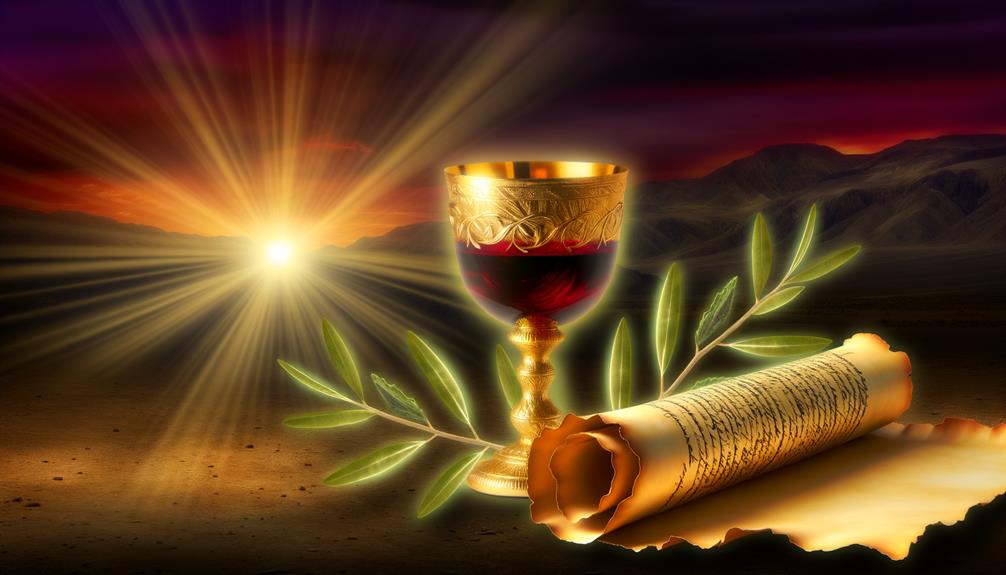
In the Old Scripture, the concept of the cup frequently symbolizes divine judgment, blessing, and covenant.
Notably, the cup of divine judgment is illustrated in Psalms 75:8, where it is filled with the foaming wine of God’s wrath, destined for the wicked. Conversely, the cup of blessing appears in Psalm 23:5, symbolizing abundance and divine favor.
Additionally, the cup serves as a covenantal symbol, as seen in Jeremiah 31:31-34, representing God’s promise of a renewed relationship with Israel.
These diverse symbols underscore the profound theological implications of the cup, reflecting its multifaceted role in conveying God’s justice, grace, and commitment.
Therefore, the Old Testament uses the cup as a potent symbol to communicate essential aspects of divine-human interaction.
The Cup of Salvation

The concept of ‘The Cup of Salvation‘ emerges prominently in Psalm 116:13, symbolizing deliverance and divine favor in the Hebrew tradition.
This phrase encapsulates not only the historical gratitude of the Israelites for God’s intervention but also offers profound spiritual implications for contemporary faith practices.
Through a theological lens, examining this cup reveals layers of meaning that bridge the ancient and modern understandings of divine grace and thanksgiving.
Biblical Symbolism Explained
Among the various symbolic elements in the Bible, the ‘Cup of Salvation’ stands out as a profound representation of divine grace and deliverance. This symbol encapsulates the essence of God’s provision and mercy towards humanity.
Theologically, the cup signifies the overflowing blessings and the promise of eternal salvation through faith. Historically, it draws from ancient practices of covenant-making, where sharing a cup often sealed agreements. Scriptural analysis reveals its depth, particularly through the lens of redemption and thanksgiving.
| Aspect | Significance |
|---|---|
| Theological | Symbolizes divine grace and eternal salvation |
| Historical Context | Derived from covenant traditions |
| Scriptural Basis | Emphasizes redemption and thanksgiving |
| Spiritual Meaning | Represents God’s mercy and provision |
This multifaceted symbol enriches the understanding of divine-human relationships in biblical theology.
Significance in Psalms
Psalm 116:13 poignantly captures the essence of the ‘Cup of Salvation‘ as an expression of gratitude and acknowledgment of God’s deliverance. In this verse, the psalmist vows to lift the cup, symbolizing a public declaration of God’s saving acts.
Historically, lifting a cup in ancient Israelite culture was intertwined with rituals of thanksgiving and covenantal faithfulness. This gesture transcends mere ritual, embodying a deep, personal response to divine intervention.
Scripturally, it connects to broader biblical themes of deliverance and divine provision, echoed in various psalms and prophetic writings. The ‘Cup of Salvation’ consequently serves as a reflection of God’s unwavering commitment to His people, inviting believers to respond with heartfelt worship and thanksgiving.
Spiritual Implications Today
Embracing the rich symbolism of the ‘Cup of Salvation,’ contemporary believers can find profound spiritual resonance in this ancient practice. It serves as a call to live in perpetual gratitude and acknowledgment of God’s continuous deliverance.
This concept, deeply rooted in Psalm 116:13, invites modern Christians to reflect on the enduring nature of divine grace.
- Gratitude: Encourages a daily practice of thankfulness for God’s unwavering salvation.
- Remembrance: Acts as a tangible reminder of Christ’s sacrifice and the covenant established through His blood.
The Cup of Wrath

The concept of ‘The Cup of Wrath‘ in biblical literature primarily symbolizes divine judgment and retribution, often portrayed in prophetic texts as a vessel of God’s anger.
This imagery is richly illustrated in passages such as Jeremiah 25:15-17 and Revelation 14:10, where nations and individuals are compelled to drink from the cup, signifying their inevitable experience of God’s punitive justice.
Theologically, it underscores the seriousness of sin and the certainty of divine accountability, serving as a stark contrast to the life-giving ‘Cup of Salvation.’
Symbolism in Prophecy
In biblical prophecy, the ‘Cup of Wrath’ serves as a powerful symbol of divine judgment and impending retribution against nations and individuals who defy God’s commandments. This metaphorical cup encapsulates various thematic elements in prophetic scripture:
- Divine Justice: The outpouring of wrath signifies God’s unwavering commitment to justice and moral order.
- Warning and Consequence: Prophets like Jeremiah and Isaiah use this imagery to warn of the dire consequences of persistent disobedience.
Scripturally, the ‘Cup of Wrath’ is vividly portrayed in passages such as Jeremiah 25:15-16 and Revelation 14:10, illustrating the profound theological implications of this symbol in the biblical narrative.
Divine Judgment Explained
Building on the prophetic symbolism, the concept of divine judgment through the ‘Cup of Wrath‘ underscores God’s active role in enacting justice against iniquity.
Scripturally, this metaphor appears in passages such as Jeremiah 25:15-17, where God commands the prophet to make nations drink from the cup, symbolizing impending destruction.
Historically, this imagery reflects ancient Near Eastern customs where a king’s cup could signify both blessing and curse, depending on its contents.
Theologically, the ‘Cup of Wrath’ conveys God’s righteous indignation towards sin and the inevitable consequences of moral decay.
This powerful symbol reminds the faithful of the seriousness of divine justice, urging repentance and alignment with divine will to avoid the dreaded outpouring of wrath.
Psalms and Abundance

Scriptural references in the Psalms often depict the cup as a symbol of divine abundance and overflowing blessings, epitomizing God’s provision and grace. This imagery is poignantly illustrated in Psalm 23:5, where the psalmist declares, ‘my cup overflows,’ signifying the superabundance of God’s kindness and sustenance. Historically, the cup represents not merely physical sustenance but also spiritual enrichment.
- Psalm 16:5: ‘The Lord is my chosen portion and my cup; you hold my lot,’ indicating divine favor.
- Psalm 116:13: ‘I will lift up the cup of salvation,’ symbolizing gratitude and deliverance.
These psalms collectively underscore the theological richness of the cup as a metaphor for divine generosity.
Prophetic Imagery
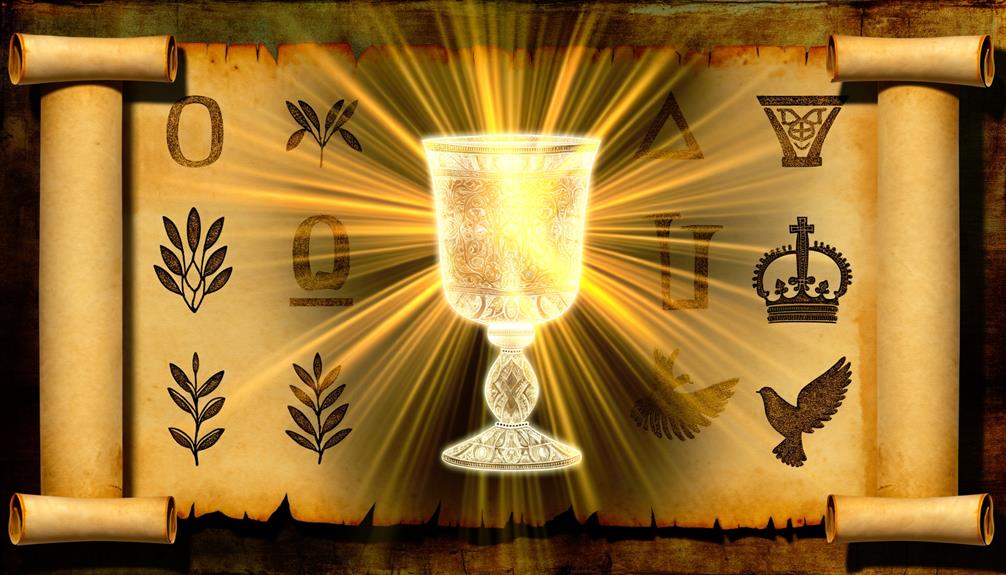
Prophetic texts within the Bible frequently employ the imagery of the cup as a powerful symbol of divine judgment and destiny. This metaphor is vividly illustrated in passages such as Isaiah 51:17, where Jerusalem is depicted as having drunk from the cup of God’s wrath, resulting in staggering and desolation.
Similarly, in Jeremiah 25:15-16, the nations are commanded to drink from the cup of God’s fury, signifying impending judgment. This symbolism underscores the irrevocable nature of divine decrees and the inescapable consequences of disobedience.
The cup, consequently, serves as a potent reminder of the seriousness with which God addresses sin and justice. This aligns with the broader prophetic theme of accountability and divine retribution within the historical context of Israel and its neighbors.
Jesus and the Last Supper
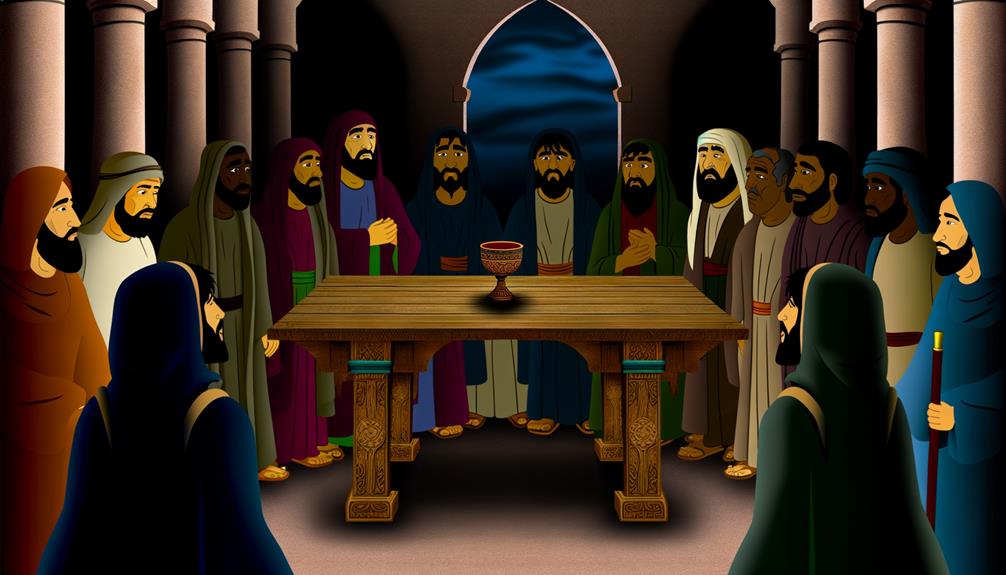
In the context of Jesus and the Last Supper, the cup holds profound theological significance as it symbolizes the New Covenant between God and humanity.
During the Passover meal, Jesus’ offering of the cup to His disciples represents the sacrificial blood He would shed for the remission of sins, echoing prophetic imagery from the Old Scripture.
This act not only fulfills ancient prophecies but also inaugurates a new era of divine grace and redemption.
Symbolism of the Cup
Rooted deeply in theological significance, the symbolism of the cup during Jesus’ Last Supper epitomizes the new covenant between God and humanity, as articulated in the synoptic Gospels. This moment is pivotal, reflecting Jesus’ sacrificial role and the profound transformation of divine-human relationships.
The cup represents:
- Sacrifice and Redemption: Jesus refers to his blood as ‘poured out for many for the forgiveness of sins’ (Matthew 26:28).
- Communion and Fellowship: Sharing the cup signifies unity among believers and their connection to Christ.
Through these layers of meaning, the cup becomes a potent emblem of faith, redemption, and divine grace.
New Covenant Significance
At the Last Supper, Jesus’ declaration of the cup as the ‘new agreement in my blood’ (Luke 22:20) redefines the relationship between God and humanity, emphasizing a transformative shift in divine grace and redemption. This pivotal moment signifies the fulfillment of Old scriptures prophecies and inaugurates a new era of covenantal promise.
By linking his sacrificial death to the cup, Jesus establishes a profound theological foundation that underpins Christian soteriology. Below is a table summarizing key aspects of this new agreement:
| Aspect | Old Covenant | New Covenant |
|---|---|---|
| Mediator | Moses | Jesus Christ |
| Sacrifice | Animal offerings | Jesus’ sacrificial death |
| Scope | Israel | All humanity |
| Significance | Law and Prophets | Grace and Redemption |
This new agreement underscores the ultimate act of divine love and reconciliation.
The New Covenant
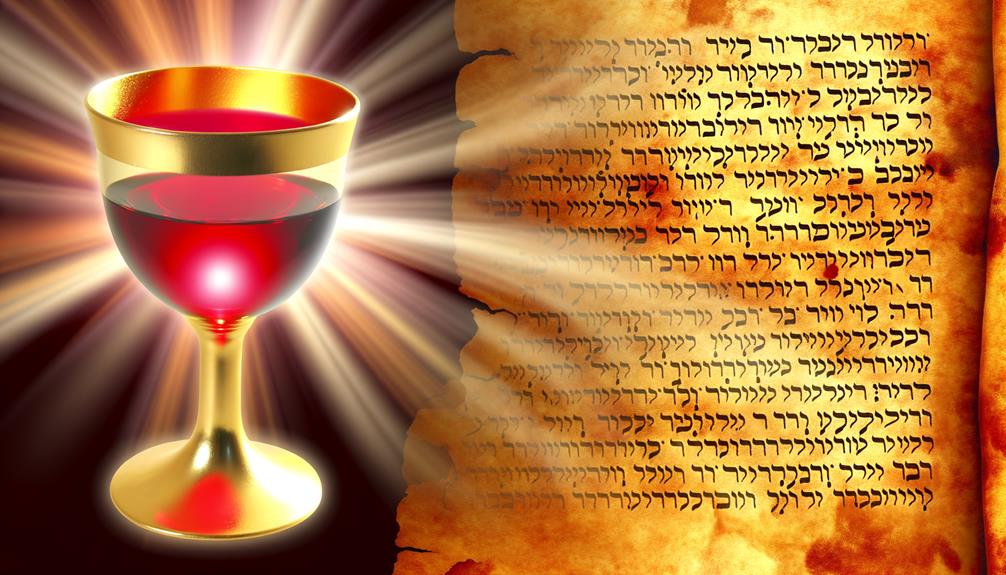
Exploring the symbolism of the cup in the context of the New Covenant reveals its profound theological significance, particularly as it pertains to the sacrificial death and resurrection of Jesus Christ.
In the Gospels, Jesus refers to the cup during the Last Supper, signifying the establishment of a new agreement through His blood (Luke 22:20). This act fulfills Old Scriptures prophecies, symbolizing a divine promise of redemption and eternal life.
Key theological aspects include:
- Atonement: The cup represents Jesus’ blood shed for the forgiveness of sins.
- Covenant Renewal: It signifies a new relationship between God and humanity.
Thus, the cup embodies the essence of Christian faith and hope.
The Cup of Suffering
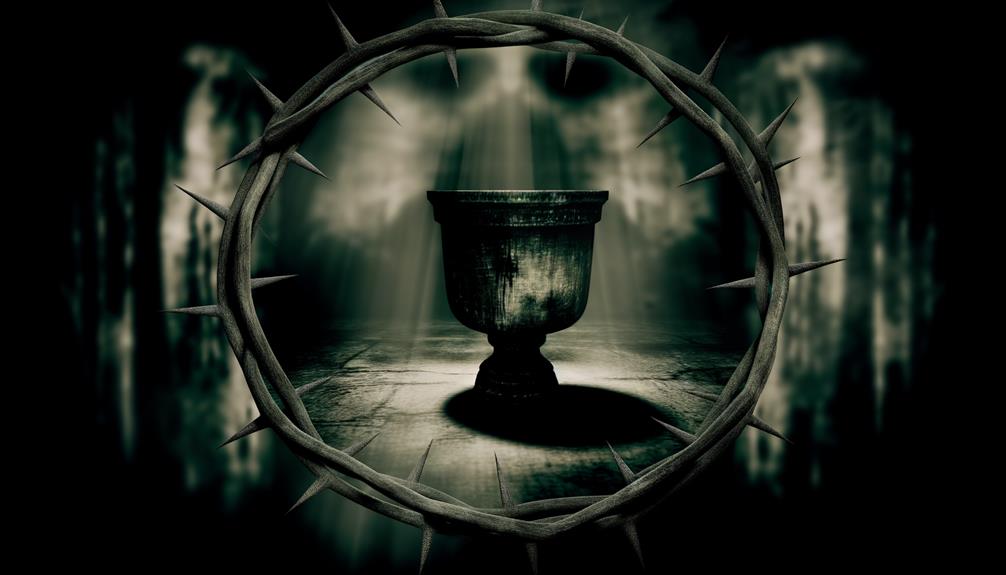
The metaphor of the cup of suffering, profoundly illustrated in Jesus’ prayer at Gethsemane (Matthew 26:39), encapsulates the intense anguish and sacrificial obedience inherent in His path to crucifixion.
In this passage, Jesus appeals to the Father, expressing His overwhelming distress while submitting to divine will: ‘My Father, if it is possible, may this cup be taken from me. Yet not as I will, but as you will.’
Historically, the imagery of the cup symbolizes a divinely ordained portion or experience, often entailing judgment or affliction (Isaiah 51:17).
Jesus’ acceptance of this cup signifies His willingness to bear humanity’s sins, fulfilling prophetic scriptures (Isaiah 53:4-5) and demonstrating ultimate obedience and love, vital themes in Christian theology.
Communion and Christian Practice
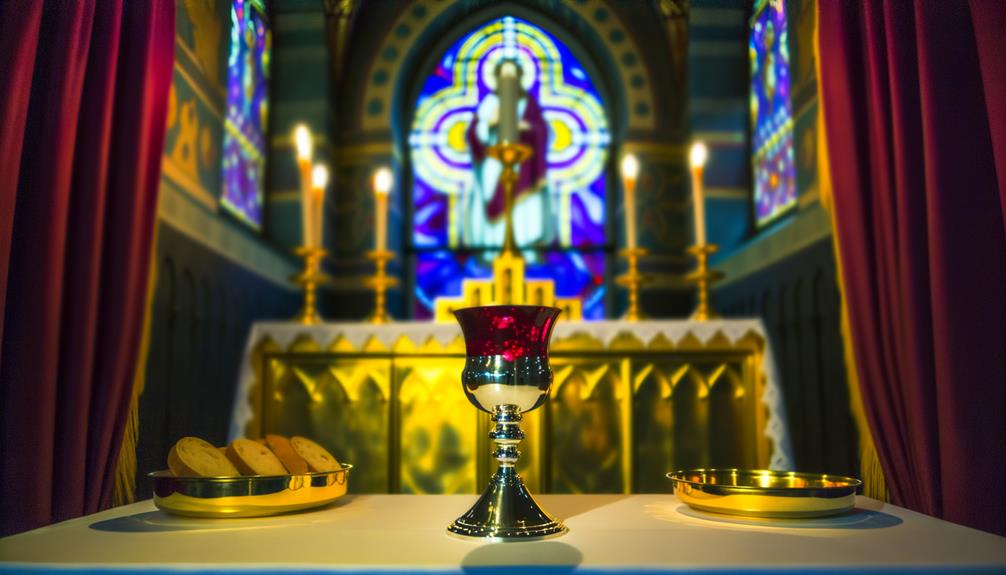
In the context of Communion, the cup represents the new covenant in Christ’s blood, a foundational element of Christian liturgical practice deeply rooted in the Last Supper narrative (Luke 22:20).
This act of sharing the cup is imbued with profound theological significance, reflecting:
- A symbol of unity: The communal sharing of the cup signifies the unity of believers in Christ.
- Remembrance and proclamation: Partaking in the cup serves as a remembrance of Christ’s sacrificial death and a proclamation of His return (1 Corinthians 11:26).
This sacrament remains a central ritual, embodying the heart of Christian worship and devotion.
Modern Interpretations

Contemporary theological discourse often reinterprets the biblical symbolism of the cup, seeking to contextualize its meaning within modern Christian life and practice. Scholars argue that the cup, representing suffering and redemption, reflects personal and communal experiences of faith today.
In alignment with historical context, the cup’s dual symbolism of wrath and blessing offers a nuanced lens through which believers can explore themes of sacrifice and divine grace. Scriptural analysis reveals that the cup’s presence in the Eucharist continues to embody Christ’s sacrificial love, encouraging reflection on personal discipleship and communal unity.
Consequently, modern interpretations emphasize the cup as a dynamic symbol for understanding contemporary spiritual journeys and the ongoing relationship between divine purpose and human existence.
Conclusion
The cup in the Bible, rich in symbolism, encompasses diverse meanings across both Covenants.
It signifies salvation and wrath, abundance and suffering, prophetic visions and the New Covenant.
Through scriptural analysis, historical context, and theological expertise, the cup emerges as a multifaceted symbol.
Its interpretations, from Old Covenant rituals to New Covenant communion, continue to influence Christian practice and modern understandings, underscoring the depth and complexity of biblical teachings.






